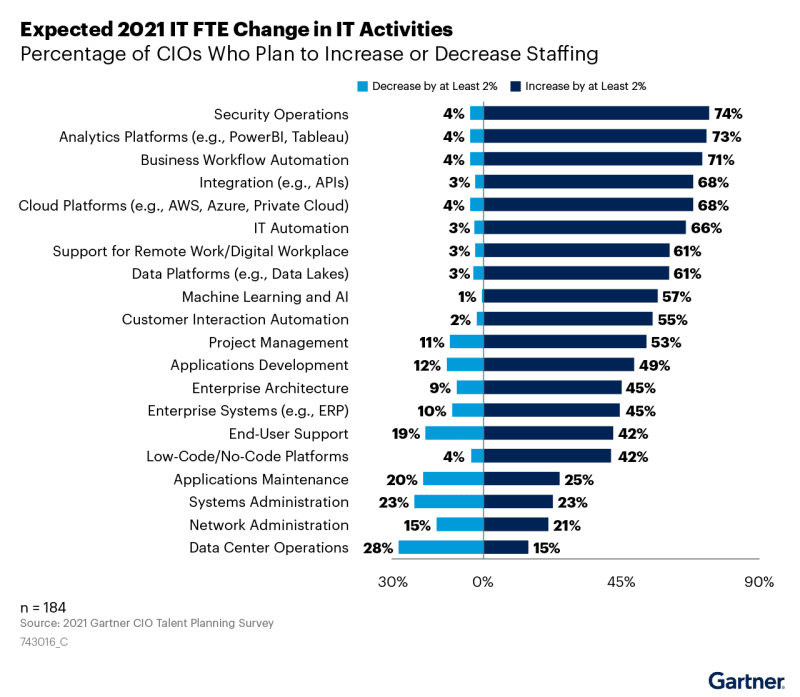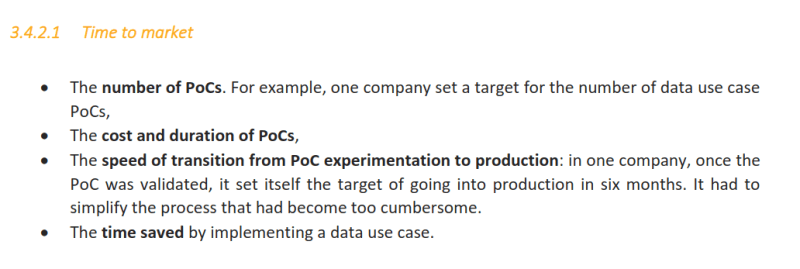❔ About
Sometimes ago, I saw this tweet from Cigref in my thread:
... and as they made it available as a pdf (recently available in English), it was quite comfortable to bring it with me on my e-reader.
After a few lines, the content was so meaningful that I decided:
- To put things in perspective for myself to better understand how my current topics intricate are
- Share some key points so anyone could benefit of this document... and go further by reading the full version
This post could hence be seen as a teaser for:
🎤 Intro : Live interview
The data strategy, a tool to achieve enterprise goals like:
- Create new services
- Achieve Operational excellence
- Corporate social responsibility
- Carbon footprint reduction
- ...
So the big questions are:
- How do we handle it
- What for
🤯 Change, change, change...
First some context about Expected 2021 IT FTE Change in IT Activities
“While CIOs plan to hire more staff in several areas critical to meeting changed consumer and employee expectations, most will not be able to meet their planned talent strategy goals without also upskilling or refocusing their existing teams,” said Mr. Charlet.
So, in my case, I could see the keypoints I invest a lot:
- 🦾 Business workflow automation
- 🔗 Integration (eg. APIs)
- ☁️ Cloud platforms
- 🤯 "upskilling or refocus of existing teams"
📖 Develop and implement a data strategy
"The data strategy touches on the very image of the organization, its values, its aspirations and projects
for the future: it really is an issue of transforming the business.""Data is an asset for the entire organization, not just for one department or business unit. This is why** companies and public administrations are transforming themselves** to make better use of this data, investing in building and implementing a data strategy that can serve their overall strategy."
☂️ The case of External risk of disruptive innovation
"The core business is being disrupted by the emergence of new players on the periphery with a business model based on using data from the original business. The question for companies is how to react."
"The specificity of this external or transversal threat is that it changes the perception of customers, which forces the company to adapt to better meet their expectations."
💡 A good way to sensitize about that may be to bring internal - and kind - disruptive innovation as part of the data culture... so we could make the enterprise adapt earlier thanks to "insiders".
📜 Develop a data strategy
Below some the high level roadmap : seeing it so clearly explained helps focus on the key points to help make things possible.
As collaborators, our mission is to help achieve the goal fixed by strategy with skills and tools.
For example, in my case a way to transform this strategy into action plan may be to:
- 🧑🤝🧑 Help develop employee's data culture : by blogging and showing what can be achieved with data and APIs in a way so everyone may understand it
- 🎯 Get Specific Business Objectives : starting from our Strategic Plan is a great way to do this
- 🔬 Identifiy relevant data to be used : as we have an up-to date cartography knwoledgebase, this is quite easy to achieve
- 🏗️ Prepare the architecture and technical bricks : this is where innovation comes in as it makes it possible to learn by doing and start deliver services at low risk but still by deliver services (and helps develop employee's data culture)
☝️ One of the objectives I want to achieve with my team is to :
"translate the data strategy into small steps that each bring value, in other words,quick wins."
So, a daily mantra could be:
"Data strategy is not just a technical issue, it is part of business transformation"
... hence it's our job to make it a daily concern.
📉 Time to market
🏛️ Data strategy pillars
- Data Governance: Establishing a framework for managing and protecting data, including defining roles and responsibilities, data quality standards, and data privacy and security measures.
- Data Architecture: Designing the structure and organization of data, including data models, data storage, and data integration methods.
- Data Management: Implementing processes and procedures for data collection, storage, cleansing, and maintenance to ensure data accuracy, consistency, and accessibility.
- Data Analytics: Utilizing data to gain insights and make informed decisions, including data analysis, data visualization, and predictive modeling.
- Data Culture: Fostering a data-driven mindset and promoting data literacy across the organization, encouraging employees to use data in their decision-making processes.
- Data Privacy and Security: Ensuring compliance with data protection regulations and implementing measures to safeguard sensitive data from unauthorized access or breaches.
These pillars work together to establish a comprehensive data strategy that enables organizations to effectively manage and leverage their data assets.
🧪 Innovation role
- Increasing Market Share: Innovation can help companies and public administrations identify new business opportunities and develop new services or products based on data. By leveraging innovative approaches and technologies, organizations can create unique value propositions that attract customers and increase their market share.
- Defending Against External Disruption: Innovation is essential for organizations to respond to external threats and disruptive innovations. By continuously exploring and adopting new technologies and data-driven approaches, companies can stay ahead of the competition and protect their market position.
- Better Adjustment of Responses to Customers/Users: Innovation enables organizations to better understand their customers or users by analyzing data and identifying patterns or trends. This understanding can lead to the development of personalized and tailored responses, improving customer satisfaction and loyalty.
- Improving Operational Excellence: Innovation can drive operational excellence by optimizing processes, reducing costs, and improving overall efficiency. By leveraging data and analytics, organizations can identify areas for improvement, make data-driven decisions, and implement innovative solutions to enhance their operations.
In summary, innovation is a critical component of a data strategy as it enables organizations to leverage data effectively, identify new opportunities, respond to external threats, enhance customer experiences, and improve operational efficiency. By embracing innovation, organizations can unlock the full potential of their data and drive sustainable growth and success.
➿ Disruption and Open innovation ?
Disruption and open innovation play a significant role in shaping the pillars of a data strategy.
According to my understanding, here's how they contribute to different aspects of a data strategy:
- 🧑🤝🧑 Data Governance: Disruption and open innovation challenge traditional data governance practices by introducing new sources of data and collaboration models. They require organizations to establish flexible governance frameworks that can adapt to changing data landscapes and accommodate external data sources.
- 🕸️ Data Architecture: Disruption and open innovation often involve the integration of new technologies and platforms. This requires organizations to design scalable and agile data architectures that can accommodate diverse data sources, handle large volumes of data, and support real-time data processing.
- 🏋️ Data Management: Disruption and open innovation generate vast amounts of data from various sources. Effective data management practices are essential to ensure data quality, data integration, and data accessibility. Organizations need to implement robust data management processes and technologies to handle the influx of data and derive meaningful insights from it.
- 📊 Data Analytics: Disruption and open innovation provide organizations with access to new data sets and analytical techniques. This enables them to uncover valuable insights, identify emerging trends, and make data-driven decisions. Organizations need to invest in advanced analytics capabilities and develop a culture of data-driven decision-making to leverage the potential of disruption and open innovation.
- 👐 Data Culture: Disruption and open innovation foster a culture of experimentation, collaboration, and continuous learning. They encourage organizations to embrace data-driven approaches and empower employees to explore new ideas and solutions. Building a data culture is crucial for organizations to effectively leverage disruption and open innovation in their data strategy.
- 🛡️ Data Privacy and Security: Disruption and open innovation introduce new challenges in ensuring data privacy and security. With the increased use of external data sources and collaboration with external partners, organizations must prioritize data privacy and security measures. This includes implementing robust data protection measures, complying with relevant regulations, and establishing secure data sharing practices.
To summarize, disruption and open innovation are integral to a data strategy as they drive organizations to adapt their data governance, architecture, management, analytics, culture, and privacy and security practices to leverage the opportunities presented by these trends.
⚡ Risks around open innovation and disrupting case
Open APIs, open innovation, and the** disruption of use cases by third parties** can pose several risks to organizations in terms of their data strategy.
Below some of the risks associated with these factors:
- Data Security and Privacy Risks: When organizations open up their APIs and share data with third parties, there is a risk of unauthorized access, data breaches, and misuse of sensitive information. This can lead to reputational damage, legal consequences, and loss of customer trust.
- Intellectual Property Risks: Open innovation and the sharing of data with third parties can expose organizations to intellectual property risks. There is a possibility that third parties may use the organization's data to develop similar or competing products/services, potentially infringing on the organization's intellectual property rights.
- Loss of Control: Opening up APIs and allowing third parties to access and use data can result in a loss of control over how the data is used, manipulated, and shared. Organizations may find it challenging to enforce data governance policies and ensure compliance with regulations.
- Competitive Disadvantage: Third parties leveraging open APIs and open innovation can disrupt traditional use cases and business models. This can lead to a loss of market share, revenue, and competitive advantage for organizations that are not able to adapt quickly to the changing landscape.
- Quality and Accuracy of Data: When third parties are involved in using an organization's data, there is a risk of data quality and accuracy issues. Organizations may have limited control over how the data is collected, processed, and validated by third parties, which can impact the reliability and integrity of the data.
- Dependency on Third Parties: Organizations relying heavily on open APIs and third-party innovation may become dependent on these external entities. If a third-party provider experiences disruptions, discontinues their services, or changes their terms and conditions, it can significantly impact the organization's operations and data strategy.
🛡️ Risk mitigation 🧑⚖️
To mitigate these risks, organizations should implement robust data governance practices*, including:
- Data access controls,
- Encryption,
- Monitoring mechanisms.
They should also establish clear agreements and contracts with third parties to ensure:
- Data security,
- Intellectual property protection,
- Compliance with regulations.
Regular audits and assessments of third-party partners can help ensure their reliability and adherence to data governance standards.
🚀 Last Words
Disruption and open innovation foster a culture of:
- 🧑🔬 Experimentation,
- 🧑🤝🧑 Collaboration,
- 📚 Continuous learning.
They both encourage organizations to embrace data-driven approaches and empower employees to explore new ideas and solutions.
Building a data culture is crucial for organizations to effectively leverage disruption and open innovation in their data strategy.
📑 Resources
- Data & Analytics Governance and Architecture: Developing and implementing a data strategy
- Expected 2021 IT FTE Change in IT Activities, Gartner
Finally, below the way we have mapped our resources as data (used on a daily basis as part of our Digital Transformation Journey):



 cigref.fr
cigref.fr







Top comments (2)
How to build a technology road map in established organizations | MIT Sloan
Focus on business outcomes combined with a strategy for building enterprise digital acumen, according to Johnson & Johnson’s CIO.